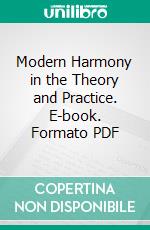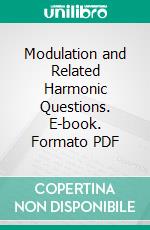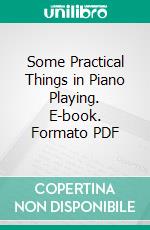Arthur Foote eBooks
eBooks di Arthur Foote
Modern Harmony in the Theory and Practice. E-book. Formato PDF Arthur Foote - Forgotten Books, 2017 -
While the old strict rules as to Secondary 7ths are given fully, the modern theory and use of these chords have received just consideration.
Modulation and Related Harmonic Questions. E-book. Formato PDF Arthur Foote - Forgotten Books, 2017 -
The author has endeavored to set forth a statement of the various means of modulation found in music from Bach to the present time; such problems as are Offered by certain composers Of the past few years, however, have not been dealt with, for in their works tonality is of set purpose made increasingly negligible, the question of modulation per se (as it has always been conceived) not being of importance. Illustrations from composers of all periods Show the practical application of principles. Harmonic questions are discussed at length in so far as they are con cerned with the matter in hand, not having been entered into purely for their own sake; in the first chapter detailed explanation is also given of some fundamental, though often imperfectly understood, points with regard to scales and key-relationship (since comprehension of and ability in modu lation presuppose thorough knowledge with regard to these matters). Chap ters X and XI touch directly but little upon real modulation, though cover ing subjects that are extremely important as aids thereto.
Some Practical Things in Piano Playing. E-book. Formato PDF Arthur Foote - Forgotten Books, 2017 -
The Making of a Tone1. To get a full tone, the piano key must be pushed down as far as it will go; if the key goes down quickly, with force, the hammer rises quickly and strikes the strings hard, thereby making a strong tone; the slower the key is pushed down, the weaker the tone. (See 16, b.)2. To push down the keys we may (1) use fingers only, keeping the hand, wrist and arm quiet; (2) play at the wrist (i.e. by swinging the hand at the wrist, keeping the wrist quiet, and the arm motionless); (3) use an arm movement, the arm being more or less relaxed according to the amount of tone desired.3. In each of these three ways the weight of the arm (from shoulder to finger tips) is an important factor. In soft playing not only are the keys put down more slowly, but less of the arm-weight is brought into action, and conversely.Bad And Good Habits.4. There are three places (joints) in the arm that must be observed; the shoulder, the elbow and the wrist. Some persons hold the shoulders stiffly and nervously, even keeping them slightly raised; others have the elbows raised, or hold them rigidly at an angle to the body; many keep the wrists stiffened. These things are all faulty and illogical.5. The only sensible way of habitually holding the arm is this: - to let the elbows hang comfortably at the sides of the body, so that if they are pulled out sideways they will instantly swing back to their former place, on account of the weight of the arms; the shoulders are to remain loose and free, not being raised in the smallest degree. We then can manage the wrist and hand easily; otherwise not.


